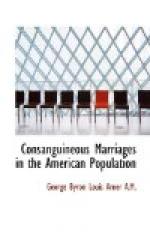TABLE
XXI.[73]
Parentage of Mental Defectives in Prussia.
-----------------------------------------------------
|
Consan- | |Uncle and
|guineous.|Cousins.|
Niece.
-----------------------------------------------------
1. Insanity (simple) | 6.5[A] | 5.8[A]|
.64[A]
Hereditary | 14.2 |
12.5 | 1.6
Not hereditary | 3.0 |
2.7 | .22
-----------------------------------------------------
2. Paralytic Insanity | 4.1 | 3.8 |
.35
Hereditary | 11.1 |
9.6 | 1.48
Not hereditary | 2.9 |
2.5 | .11
-----------------------------------------------------
3. Epileptic Insanity | 5.6 | 4.9 |
.64
Hereditary | 11.7 |
9.9 | 1.57
Not hereditary | 3.5 |
3.2 | .29
-----------------------------------------------------
4. Idiocy and Imbecility| 14.4 | 12.8 |
1.58
Hereditary | 21.6 |
19.3 | 2.12
Not hereditary | 11.5 |
10.2 | 1.37
-----------------------------------------------------
[A] Per thousand.
[Footnote 73: Feer, op. cit., pp. 13-14.]
From these tables we may infer that consanguinity influences idiocy far more than it does insanity, but it is not entirely clear why the number of hereditary cases should be relatively smaller among the idiotic. Since insanity is more likely to have some more definitely assignable cause than idiocy, we should expect the percentage due to heredity to be lower and consequently the influence of consanguinity less.
It is generally admitted that a tendency toward insanity is inheritable, and it seems probable that this tendency as well as other neuroses may be intensified through double heredity. A case in point can be found in the Shattuck genealogy.[74] For four generations in the S. family there is no indication of neurosis. The average number of children to a family had been eight, few children died young and all were prosperous farmers. But in 1719 J.S. married E.C. and their son Z.S. is thus described: “He was sometimes subject to depression of spirits; and some peculiar traits of character in a few branches of his family seem to have originated with him.” He married A.C., a niece of his mother. They both lived to be over 80 and had ten children, of whom three were insane; only six married, and of these only two are known to have left surviving children. One of these a daughter, S.S., married E.S., a nephew of her father, and himself the offspring of a second cousin marriage within the S. blood. E.S. and S.S. had five children, all of whom married, and there is no further mention of insanity. We may suppose, then, that the C. stock was neurotic, and that a consanguineous marriage within that stock, although of the S. surname, intensified the tendency into insanity, but with a further infusion of the normal S. blood the morbidity was eliminated. It is very evident that the heredity and not the consanguinity was the cause of these three cases of insanity.




